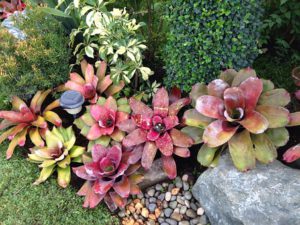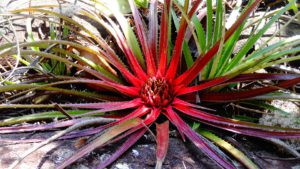Neoregelia Plant Care Tips

It’s estimated that there are some 2,700 bromeliads which I find to be so amazing, these garden beauties come in many shapes, colors, and sizes some of them even having thorny edges. Bromeliads are popular plants that are used both outdoors as well as indoor gardens, what I love about these plants is the bright color pop that can make a garden design so amazing.
Bromeliads are so easy to care for, so for those of you who are always on the go but want a plant where little attention is given then bromeliads are the plants for you. I have worked with bromeliads on many gardens and especially interior plantscape projects and have seen what these plants can do, bromeliads are simply amazing and will work wonders for you.
In this article, however, we will be looking at one such species of bromeliad that’s in this large family which is the neoregelias. The neoregelia belongs to the family of the Bromeliaceae in the genus of flowering plants. These garden beauties are native to the rainforest of South America. Neoregelias can be grown attached to the branches and trunks of trees, the center cup of the neoregelias collects water, frogs takes advantage of the water that is collected in the center cup by laying their eggs. For more on the care and growth of neoregelias, let’s take a closer look.
The planting location
Neoregelias can be acclimated or trained to thrive in either high levels of light, indirect bright light, or filtered light.
The soil type
Neoregelias can grow in just about any soil mix.
Watering your neoregelias
Water your neoregelias from the center cup, the soil can also be dampened, during the winter months discontinue watering from the center cup which can lead to rot.
Fertilizing your neoregelias
Fertilize your neoregelias during the growing season with a water-soluble quick-release fertilizer. Place some of the fertilizer in the center cup and also in the soil.
Garden insect pests of neoregelias
Keep a watch for these garden insect pests and treat them soon as spotted.

- Scales
- Aphids
- Mealybugs
When it comes to garden insects best such as scales, aphids and mealybugs treat right away when spotted. The use of insecticidal soap or neem oil will bring control. You may also have visits from snails and slugs, either handpick them and eliminate them by throwing them into a bucket of soapy water or applying snail bait.
Diseases of neoregelias
Controlling or avoiding these diseases will keep your neoregelias growing healthy.
- Helminthosporium leaf spot
- Crown and Root Rot
- Rust disease
- Pythium
Helminthosporium leaf spot
This disease which is caused by a fungus shows up as leaves that are limp and brown, infected leaves also have blisters that are yellow, these blisters will enlarge with sunken brown spots as this disease progresses the leaves will collapse.
Crown and Root Rot
Crown and root rot disease symptoms include the crown turning brown and soggy, gentle tugging of the leaves will cause them to detach from the plant, foul odors will also emanate from the center of the plant. Overwatering your neoregelias and allowing them to sit in soils that are waterlogged encourages this fungal disease.
Rust disease
Symptoms of rust disease show up as light yellow or white spots on the leaves surface, the undersides of the leaves will develop liquid-filled blisters that are a rust color. The rust-colored bumps will also appear on the leaves undersides.
Pythium
The symptoms of pythium are Wilting, the plant’s roots turn mushy, and dark infected plants also produce and of color. This disease attacks the plant’s roots.
Growing neoregelias from containers
Neoregelias will make good table plants, these garden beauties can be grown from containers and placed on filing cabinets, office desks, kitchen tables, and counters entertainment centers, etc… when growing neoregelias from containers this can be done in one of two ways. Chose a decorative container that has drain holes, or if the container does not have drain holes place a saucer inside to rest at the bottom.
Next, leave your plant in the grower’s pot and place the grower’s pot in the decorative container, normally you will not need to add pine bark or Spanish moss but if either of one is needed to complete your design then, by all means, do so. Your neoregelia should be placed near a west window where it can receive indirect light.
Add water to the center cup and dampen the soil a bit also, a liquid feed fertilizer at half strength will keep your neoregelia growing healthy. Rainwater is much better because tap water has fluoride and chlorine. Once a week ensure that the sauce is free of water that drains.
The second option is to fill the decorative pot with soil about up to a quarter or half depending on the size of the root ball. Next, remove your neoregelia from the grower’s pot and place it in the decorative container, ensure that the plant is centered. Now backfill with potting soil and gently firm around the plant. However, when using this method of planting directly into the soil the decorative container must have drain holes. Follow the above examples when it comes to watering, fertilizing, and treating for garden insect pests.
Growing neoregelias from baskets
When growing neoregelias from hanging baskets follow the above example when growing from containers and follow maintenance practices as discussed.
Installing neoregelias in the home garden
Below are just a few places to grow neoregelias from the home garden.
1. Neoregelias will look great growing in a rock or low maintenance garden.
2. I have seen a garden design where part of a lawn was removed and the center was filled with neoregelias properly spaced.
3. Install them in a circle around the trunks of trees.
4. Secure them to the trunk of trees.
5. Use them as a front drop in your garden plant bed.
6. Install neoregelias alongside a garden path walkway.
The growth and care of neoregelias indoors
When growing neoregelias indoors place them in an area that gets indirect or filtered bright light. The room temperature can be around 55ºF or higher, rainwater is ideal when watering your neoregelia, place water in the center cup. You can create humidity for your neoregelia by misting the leaves 2-3 times a week.
Neoregelia Pups
What I love about neoregelias is that they will continue to reproduce for you helping you to save on that hard-earned dollar. A pup is the offset of the parent that grows from the base of the parent plant. Although pups can develop at just about any time they will begin to grow after the parent plant blooms.
Once the pups are removed the parent plant will continue to produce pups for a year or two, the parent plant can also have multiple pups growing at the same time.
When removing the pups from the parent the pups should be 1/3 to 1/2 the size of the mother plant, to perform this procedure scissors or a sharp knife is ideal, ensure whichever one is used is sterilized. When making the cut or removing the pup place your knife as close to the parent plant and slice in a downward position being very careful not to damage either plant.
Potting Pups
So you are now ready to start the next generation of neoregelias here is what to do. The pots that are chosen should have drain holes for water drainage. Fill the pot with good potting soil and gently press your pups in the soil or what you can do and it’s optional and that is dip the pup in the water where you made the cut and then dip that same end in root tone which is a growth hormone.
Make a hole or holes in the soil if it more than one pup, place that end with the root ton in the soil, and cover the hole by packing very gently around the base of the pup. Dampen the soil just enough watering too heavily will cause the root tone to wash away. Don’t allow the soil to dry because at this stage the pups are trying to develop a root system. Once the pups begin to grow more than 12 inches they can be separated and place into individual pots.
The final word
Neoregelias can be grown both out and indoors, these garden beauties are popular and are used on many landscapes and garden designs including the interiors. Neoregelias are hardy and will bring that need flavor with their colorful leaves, what I love about the neoregelias is that because of the colorful leaves you are sure to have a garden that continually gives that tropical look. A plant that is easy to grow and not fussy at all this garden beauty will work wonders for you.
About the author
Norman loves being in the garden, both at home and for his job....
he is 'Natures Little helper' being outdoors, growing his vegetables and flowers from an early age.
Now having spent over 22 years in the profession he want to give some of his knowledge to others...
his vast array of hints and tips you will find scattered over this site will help you no end growing plants in your garden.
